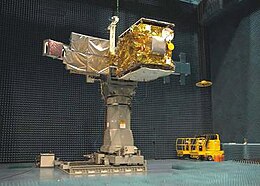
The Polar Satellite Launch Vehicle (PSLV) is an expendable medium-lift launch vehicle designed and operated by the Indian Space Research Organisation (ISRO). It was developed to allow India to launch its Indian Remote Sensing (IRS) satellites into Sun-synchronous orbits, a service that was, until the advent of the PSLV in 1993, only commercially available from Russia. PSLV can also launch small size satellites into Geostationary Transfer Orbit (GTO).

The Indian National Satellite System or INSAT, is a series of multipurpose geostationary satellites launched by the Indian Space Research Organisation (ISRO) to satisfy telecommunications, broadcasting, meteorology, and search and rescue operations. Commissioned in 1983, INSAT is the largest domestic communication system in the Indo-Pacific Region. It is a joint venture of the Department of Space, Department of Telecommunications, India Meteorological Department, All India Radio and Doordarshan. The overall coordination and management of INSAT system rests with the Secretary-level INSAT Coordination Committee.

Geosynchronous Satellite Launch Vehicle (GSLV) is a class of expendable launch systems operated by the Indian Space Research Organisation (ISRO). GSLV has been used in fifteen launches since 2001.
GSAT-3, also known as EDUSAT, was a communications satellite which was launched on 20 September 2004 by the Indian Space Research Organisation. EDUSAT is the first Indian satellite built exclusively to serve the educational sector. It is mainly intended to meet the demand for an interactive satellite-based distance education system for the country.

GSAT-2 was an experimental communication satellite built by the Indian Space Research Organisation (ISRO) and launched on one of the first GSLVs. The satellite was positioned at 48 deg east longitude in the geo-stationary orbit.
The Tel Aviv University Ultraviolet Explorer, or TAUVEX, is a space telescope array conceived by Noah Brosch of Tel Aviv University and designed and constructed in Israel for Tel Aviv University by El-Op, Electro-Optical Industries, Ltd. acting as Prime Contractor, for the exploration of the ultraviolet (UV) sky. TAUVEX was selected in 1988 by the Israel Space Agency (ISA) as its first priority scientific payload. Although originally slated to fly on a national Israeli satellite of the Ofeq series, TAUVEX was shifted in 1991 to fly as part of a Spektr-RG international observatory, a collaboration of many countries with the Soviet Union leading.

The Launch Vehicle Mark-3 or LVM3 is a three-stage medium-lift launch vehicle developed by the Indian Space Research Organisation (ISRO). Primarily designed to launch communication satellites into geostationary orbit, it is also due to launch crewed missions under the Indian Human Spaceflight Programme. LVM3 has a higher payload capacity than its predecessor, GSLV.
The GPS-aided GEO augmented navigation (GAGAN) is an implementation of a regional satellite-based augmentation system (SBAS) by the Government of India. It is a system to improve the accuracy of a GNSS receiver by providing reference signals. The Airports Authority of India (AAI)'s efforts towards implementation of operational SBAS can be viewed as the first step towards introduction of modern communication, navigation and surveillance / air traffic management system over the Indian airspace.

The CE-7.5 is a cryogenic rocket engine developed by the Indian Space Research Organisation to power the upper stage of its GSLV Mk-2 launch vehicle. The engine was developed as a part of the Cryogenic Upper Stage Project (CUSP). It replaced the KVD-1 (RD-56) Russian cryogenic engine that powered the upper stage of GSLV Mk-1.
GSAT-5P, or GSAT-5 Prime, was an Indian communications satellite which was lost in a launch failure in December 2010. Part of the Indian National Satellite System, it was intended to operate in geosynchronous orbit as a replacement for INSAT-3E.
GSAT-14 is an Indian communications satellite launched in January 2014. It replaced the GSAT-3 satellite, which was launched in 2004. GSAT-14 was launched by a Geosynchronous Satellite Launch Vehicle Mk.II, which incorporated an Indian-built cryogenic engine on the third stage.
GSAT-10 is an Indian communication satellite which was launched by Ariane-5ECA carrier rocket in September 2012. It has 12 KU Band, 12 C Band and 6 lower extended c band transponders, and included a navigation payload to augment GAGAN capacity. Following its launch and on-orbit testing, it was placed in Geosynchronous orbit at 83.0° East, from where it will provide communication services in India.
GSAT-15 is an Indian communication satellite similar to GSAT-10 to augment the capacity of transponders to provide more bandwidth for Direct-to-Home television and VSAT services. It was successfully launched on 10 November 2015 at 21:34:07 UTC aboard an Ariane 5 rocket, along with the ArabSat 6B satellite.

The SCE-200 is a 2 MN thrust class liquid rocket engine, being developed to power Indian Space Research Organisation's (ISRO) existing LVM3 and upcoming heavy and super heavy-lift launch vehicles. It is being developed by the Liquid Propulsion Systems Centre (LPSC) of ISRO, and is expected to have first flight in 2020s.

GSAT-7A is an advanced military communications satellite meant primarily for the Indian Air Force with Indian Army using 30% of capacity.

GSAT-19 is an Indian communications satellite launched by the Indian Space Research Organisation aboard an LVM3 on 5 June 2017.

GSAT-6A was a communication satellite launched by the Indian Space Research Organisation (ISRO) It featured a 6-metre (20 ft) unfurlable S-band antenna similar to the one used on GSAT-6. Around 17 minutes after lift-off, the three stage GSLV Mk.II rocket flying on GSLV F08 mission successfully injected the satellite into a geosynchronous transfer orbit. Due to power failure during its orbit raising burns the communication was lost with GSAT-6A before it could reach its final circular geostationary orbit (GSO).

GSAT-29 is a high-throughput communication satellite developed by the Indian Space Research Organisation (ISRO). The mission aims at providing high-speed bandwidth to Village Resource Centres (VRC) in rural areas. The two Ku and Ka operational payloads will provide communication services to Jammu and Kashmir and Northeast India under Digital India programme. At the time of launch GSAT-29 was the heaviest satellite, weighing 3,423 kg (7,546 lb), that was placed in orbit by an Indian launch vehicle. Approved cost of GSAT-29 is ₹175.63 crore (US$21 million).












